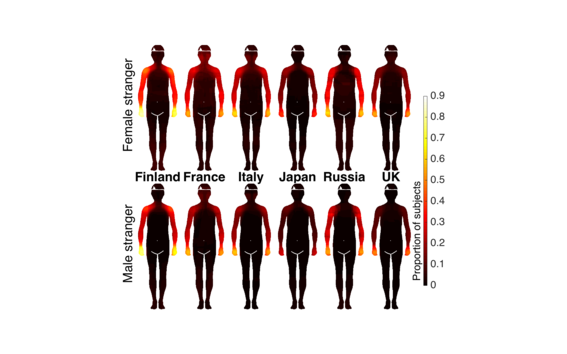Brain maps reveal: cuddles with loved ones are universal – but hugging strangers depends on culture

According to a recent doctoral study, cultural differences regarding physical touch between close partners are smaller than was believed. Different cultures are more comfortable with different levels of contact from strangers, and what counts as acceptable physical contact in public spaces changes based on where you are. The brain data also reveals whether the relationship between the person touching and the one being touched is close or not.
Social touch includes all intentional touching of another person, such as hugging or shaking hands. Social touch also always contains an emotional message, such as care for the other person or being sorry about a situation. Juulia Suvilehto carried out the research and she will be defending her doctoral dissertation on the subject of social touch at Aalto University on 15 November.
Ms Suvilehto’s study compares the way in which Finnish, Russian, Italian, British, French and Japanese people let themselves be touched by other people. Her research explores how people use social touch with those close to them, with acquaintances, and with strangers. Over 1,600 people participated in the Internet questionnaire, in which they marked on a picture of the human body the areas where they would let different members of their social networks touch them. Prior to this, differences between cultures had been studied primarily by observing touching actions in public places.
“The study indicates that the difference between cultures is greatest in the areas of what level of touch is accepted from strangers and in public places. In all cultures, every step towards greater closeness, every step towards a stronger social relationship, corresponds with an increase in the size of the area where physical touch is permitted”, explains Juulia Suvilehto.
The touch maps created based on the questionnaire results indicate that cultural differences with regards to social touch are smaller than was previously believed. The closer the social relationship between two people, the more often they let the other person touch their body and the larger the permitted area is – irrespective of country or culture.
The foundation of social touch in the nervous system was examine using a functional magnetic resonance imaging study in which 20 individuals participated. The brain imaging indicated that the processing of social touch by the brain depends on what kind of relationship there is between the person touching and the one being touched. Previously it was thought that the sensory cortex deals primarily with the physiological properties of touch.
“All touch is processed in the brain by the somatosensory cortex, and gentle stroking is also processed separately in the insular cortex – regardless of who is touching. The relationship between the person touching and the one being touched has an effect on the brain response, and a computer is able to distinguish – based on the nervous response pattern produced by both brain areas – whether the person touching is the partner of the person being touched or a stranger”, Suvilehto explains.
In many areas, digitalisation has reduced the amount of physical interaction – and therefore also opportunities for physical touch.
“What happens to our relationships with partners and others if we communicate with each other more via the internet or other technological means and less through face-to-face encounters? The research is not yet able to tell us what happens when person-to-person physical touch decreases”, Ms Suvilehto concludes.
Professor Lauri Nummenmaa of the University of Turku is Juulia Suvilehto’s thesis adviser and professor Mikko Sams will be acting as custos.
Enquiries:
Doctoral dissertation: Maintaining social bonds via touching: A cross-cultural study
Juulia Suvilehto
[email protected]
tel: +358 (0)50 344 3439
- Published:
- Updated:
Read more news

Aalto Open Science Award ceremony brought together Aaltonians to discuss open science
Last week we gathered at A Grid to celebrate the awardees of the Aalto Open Science Award 2023 and discuss open science matters with the Aalto community.
Seed funding available to boost collaboration between Aalto, KU Leuven and University of Helsinki
Aalto University, KU Leuven and the University of Helsinki launch the 2nd exploratory seed funding call to explore research collaboration possibilities. The funding call is open until 10 September 2024.
Professor Peter Hans Matthews works as a Fulbright-Aalto Distinguished Chair scholarship holder at the Department of Economics
Fulbright programmes and scholarships are highly appreciated in the United States